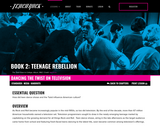
In this lesson, students will investigate the vast cultural impact on American culture of teen dance shows in general, and the Twist in particular.
- Subject:
- Arts Education
- Music
- Material Type:
- Full Course
- Provider:
- TeachRock
- Date Added:
- 08/06/2019

In this lesson, students will investigate the vast cultural impact on American culture of teen dance shows in general, and the Twist in particular.
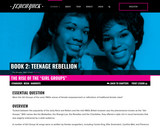
In this lesson, students will evaluate what the emergence of the Girl Groups says about the roles of girls and women in the early 1960s, as the nation sat on the threshold of a new Women's Rights movement that would challenge traditional female roles. In 1963, Betty Friedan published The Feminine Mystique, widely considered a milestone in the emerging feminist movement and it came at the peak of the Girl Groups' popularity. Did the success of the Girl Groups signal a new female empowerment, under which girls and women could finally come out from the shadows of Rock and Roll and tell the world what was on their minds? Or did the very labels "Girl Group" and "girl singer" and the focus of so many of their songs on the search for the ideal man simply reflect the traditional domestic roles of women as wives and mothers?
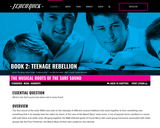
In this lesson students will investigate the different elements of the Beach Boys' Surf sound by visiting four listening stations and identifying some essential elements of their early music. These elements include rich vocal harmonies, a production aesthetic influenced by Phil Spector's "Wall of Sound" recordings, Chuck Berry-inspired electric guitar riffs, and the liberal use of "reverb" effects facilitated by technical innovations to Fender amplifiers in the early 1960s.
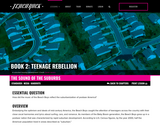
In this lesson, students will analyze the rise of the suburbs, and the ways in which the Beach Boys made music that evoked this important demographic trend.
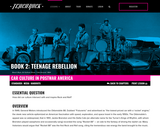
Using a selection of songs, statistics, television spots, archival films, and magazine advertisements, students investigate how the postwar resurgence of the U.S. automotive industry coincided with the rise of the teenager, the two intersecting in Rock and Roll culture.

In this lesson, students embark on a "walking tour" of Memphis, using the city as a case study through which to view complex race relations and integration issues that affected communities across the U.S. While plotting points of historical interest on a map, students consider how artists such as Elvis, the Mar-Keys, and Booker T. and the MGs resisted social norms through their music and performances. Listening to oral history from Stax owner Jim Stewart, students explore how an integrated record label operated in the middle of a segregated community and was able to create a unique and powerful Soul sound that signaled a shift in race relations in America.
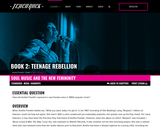
In this lesson, students will watch a 25-minute video, Aretha Franklin ABC News Close Up (1968), as a pre-lesson activity. In class, students examine a timeline of landmark events that occurred during the women's movement from 1961 to 1971. While watching multiple live performances of Aretha Franklin, including "Dr. Feelgood," "Do Right Woman," "Respect," "(You Make Me Feel Like) A Natural Woman," and "Chain of Fools," students will seek to identify Gospel influences and investigate whether issues related to women's rights are reflected in the songs as well. The extension activity includes an insightful personal narrative that provides an account of sexism that existed during the Civil Rights era.
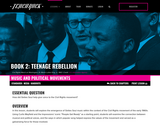
In this lesson, students will explore the emergence of Sixties Soul music within the context of the Civil Rights movement of the early 1960s. Using Curtis Mayfield and the Impressions' iconic "People Get Ready" as a starting point, students will examine the connection between musical and political voices, and the ways in which popular song helped express the values of the movement and served as a galvanizing force for those involved.
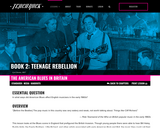
Central to this lesson is a comparison of Cliff Richard and the Shadows, as an example of early 1960s British popular music, with the Blues that a young person in the U.K. might have seen at an American Folk Blues Festival. Students will get a chance to consider what the Blues might have meant to musicians like Cyril Davies, Alexis Korner, and Long John Baldry, all key figures in the British Blues explosion.
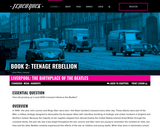
In this lesson, students will work in groups to discover how growing up in post-WWII Liverpool influenced the Beatles, nurtured their fascination with American music and culture, and helped them become a force that would in turn take American culture by storm in the 1960s.
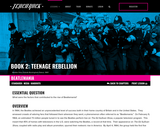
The Beatles' skilled songwriting abilities, sophisticated pop sensibilities, and power as an ensemble were all key factors in the rise of Beatlemania. However, other factors also contributed to their popularity. Teen idols such as Elvis and Frank Sinatra had captured the hearts and minds of America's youth before, but there was something magnetic and particularly approachable about these four "mop-tops"from Liverpool named John Lennon, Paul McCartney, George Harrison, and Ringo Starr. They seemed more like the boys next door than heartthrobs to be placed on a distant pedestal. And this image was no accident. Under the guidance of their manager Brian Epstein, they had carefully crafted a persona as a youthful, fun-loving band, friends with whom a young audience could identify.

In this lesson, students will investigate the Stones' early musical development and their burgeoning relationship with American Blues.
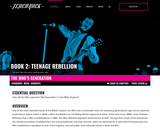
This chapter's lessons will look hard at the question of what Britain meant to Stateside audiences. The strength of the British Invasion would have been much diminished if the audiences in the United States were not eager for what was being delivered. What was the context of the Invasion? What needs did it answer? This chapter will explore it all.
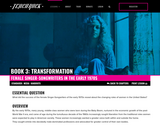
By the early 1970s, many young, middle-class women who were born during the Baby Boom, nurtured in the economic growth of the post-World War II era, and came of age during the tumultuous decade of the 1960s increasingly sought liberation from the traditional roles women were expected to play in American society. These women increasingly wanted a greater voice both within and outside the home. They sought entrance into decidedly male-dominated professions and advocated for greater control of their own bodies.
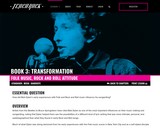
In this lesson, students explore how Dylan's early musical experiences reflect an artist with an uncanny ability to create something new out of what had come before, and how he sowed the seeds of a Folk/Rock and Roll hybrid that would have enormous influence on American popular music.
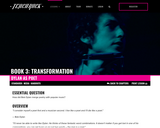
In this lesson, students will investigate Dylan as poet by comparing the literary structure of "Subterranean Homesick Blues" and Allen Ginsberg's poem "Howl." They will investigate the differences between poetry and song and examine the similarities between the two in terms of textual structure and style, using their analyses to write original extensions of the poem or song.
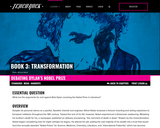
The Swedish Academy awarded Bob Dylan the Nobel Prize in Literature for "having created new poetic expressions within the great American song tradition." In this lesson, students consider the role Dylan has played in both literature and the American song tradition, and debate whether his work indeed constitutes "new poetic expressions" worthy of the prestigious award.

This lesson introduces the Folk Rock phenomenon with a look at the genre's roots in American Folk music traditions. Students will read a brief but colorful description of Folk music from the vantage point of American master Woody Guthrie and also view footage of Guthrie's protege, Pete Seeger, singing and talking about Folk music. Students will hear a later version of one of Pete Seeger's most famous songs (co-written with Lee Hays), "If I Had A Hammer," and assess the extent to which the "transitional" version of the song, performed by Peter, Paul and Mary, was true to the original spirit of Seeger's version. Finally, a more fully formed version of the Folk Rock sound will be considered by way of a further comparison between Seeger's "Turn, Turn, Turn" and a cover of the song by the Byrds, which went to No. 1 on the Billboard singles chart in 1965.
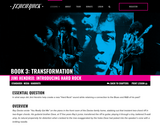
This lesson will consider the manner in which Hard Rock pushed overdriven, distorted guitar to the front. It will contrast an R&B style, often driven by keyboards and horn sections, with Hendrix's "Purple Haze," where the guitar takes center stage, with only drums and bass as accompaniment. The lesson will also explore the way Hendrix was received not as a journeyman from the world of R&B, but as a phenomenon that seemed to arrive as if from nowhere.

How did Rock and Roll serve as an expressive tool for the working-class youth of Detroit?